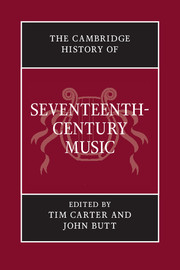Book contents
- Frontmatter
- 1 Renaissance, Mannerism, Baroque
- 2 The seventeenth-century musical ‘work’
- 3 Music in the market-place
- 4 Music in new worlds
- 5 Music and the arts
- 6 Music and the sciences
- 7 The search for musical meaning
- 8 Power and display: music in court theatre
- 9 Mask and illusion: Italian opera after 1637
- 10 The Church Triumphant: music in the liturgy
- 11 Devotion, piety and commemoration: sacred songs and oratorios
- 12 Image and eloquence: secular song
- 13 Fantasy and craft: the solo instrumentalist
- 14 Form and gesture: canzona, sonata and concerto
- Appendix I Chronology
- Appendix II Places and institutions
- Appendix III Personalia
- Index
- References
11 - Devotion, piety and commemoration: sacred songs and oratorios
Published online by Cambridge University Press: 28 March 2008
- Frontmatter
- 1 Renaissance, Mannerism, Baroque
- 2 The seventeenth-century musical ‘work’
- 3 Music in the market-place
- 4 Music in new worlds
- 5 Music and the arts
- 6 Music and the sciences
- 7 The search for musical meaning
- 8 Power and display: music in court theatre
- 9 Mask and illusion: Italian opera after 1637
- 10 The Church Triumphant: music in the liturgy
- 11 Devotion, piety and commemoration: sacred songs and oratorios
- 12 Image and eloquence: secular song
- 13 Fantasy and craft: the solo instrumentalist
- 14 Form and gesture: canzona, sonata and concerto
- Appendix I Chronology
- Appendix II Places and institutions
- Appendix III Personalia
- Index
- References
Summary
To study the vast amount of sacred and spiritual music outside the liturgy as a part of the great efflorescence of religious expression in seventeenth-century Europe (not to mention its outposts in the Americas and in Asia) is to encounter a fascinating repertory in a little-known context. From a ‘top down’ perspective, historians have marked the century as one wherein structures became increasingly formalised, the distinctions between Christian churches became more marked, and belief systems were rigidified, all in a process called (for northern Europe) ‘confessionalisation’. Whether or not one adheres to the historiographical truism of the ‘crisis of the seventeenth century’, it is clear that the destruction wrought in central Europe by the last major conflict to be waged, at least nominally, on confessional grounds – the Thirty Years War (1618–48) – as well as the increasing difficulty in reconciling religious and empirical knowledge (a problem provisionally bridged, if not solved, by Descartes) had a real effect on sacred music, whether directly or indirectly.
Yet crisis and separation were not the whole story. In all the traditions – Calvinist, magisterial Protestant (Lutheran and Anglican), Roman Catholic – the century was characterised by one or another form of a turn towards interiority: the believer’s personal relationship with Christ, his or her internal illumination, the reality of sin, the vanity of the world, and the possibility for redemption. The best-known manifestation of this trend was Franco-Spanish Quietism, finally condemned but not entirely cowed by Pope Innocent XI’s decree Caelestis pastor (1687). Similarly, ‘pre-Pietist’ streams in German Lutheranism, and even the ‘metaphysical’ bent of English religious poetry, bear witness to the lasting effect of this piety, in part as a last flowering of the devotio moderna, and in part as a reaction to the new epistemologies and political strife.
- Type
- Chapter
- Information
- The Cambridge History of Seventeenth-Century Music , pp. 324 - 377Publisher: Cambridge University PressPrint publication year: 2005



